Using halotolerant Azotobacter chroococcum W4ii from technosoils to mitigate wheat salt stress
- PMID: 39148935
- PMCID: PMC11325138
- DOI: 10.12688/openreseurope.15821.4
Using halotolerant Azotobacter chroococcum W4ii from technosoils to mitigate wheat salt stress
Abstract
Background: Technosoils in Inowrocław, central Poland, are impacted by human activities and exhibit high salinity (ECe up to 70 dS/m) due to a soda lime repository. These saline environments pose challenges to plant growth and soil health. However, they also offer an opportunity for the evolution of microorganisms adapted to such conditions, including plant growth-promoting rhizospheric (PGPR) bacteria. The hypothesis tested here was that introducing PGPR bacteria from these environments could boost degraded soil performance, leading to better plant biomass and improved pathogen defense.
Methods: Azotobacter chroococcum W4ii was isolated from the rhizosphere of wheat ( Triticum aestivum L.) for its plant growth properties on wheat plants under salt stress.
Results: Wheat seeds co-inoculated with A. chroococcum W4ii under 200 mM salt stress showed significant improvement in various growth parameters such as seeds germination (by 130%), shoot biomass (15%), chlorophyll b content (40%) compared to un-inoculated ones. Bacterial inoculation decreased the level of malondialdehyde (MDA) by 55.5% (P<0.001), whereas it elevated the antioxidative enzymatic activities of peroxidase (POD) by 33.69% (P<0.001). The test isolate also significantly (P<0.05) enhanced the level of defense enzymes like β-1,3-glucanase, which can protect plants from infection by pathogens. The bacterium could also successfully colonize the wheat plants.
Conclusions: These results indicate that A. chroococcum isolated from the technosoil has the potential to promote wheat growth under salt stress and can be further used as a bioinoculant in the salt affected agricultural fields.
Keywords: Azotobacter chroococcum; PGPR; Salt stress; Technosoil; Triticum aestivum L..
Copyright: © 2024 Binod Kumar S et al.
Conflict of interest statement
No competing interests were disclosed.
Figures





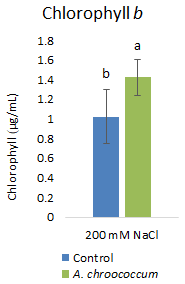

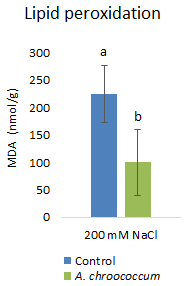
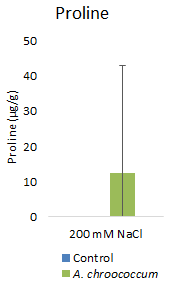
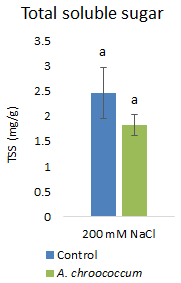

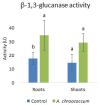
Similar articles
-
Effect of Azotobacter chroococcum and Rhizophagus irregularis on morphological and biochemical traits of bitter gourd under saline conditions.Sci Rep. 2025 Jul 2;15(1):23518. doi: 10.1038/s41598-025-08862-x. Sci Rep. 2025. PMID: 40603675 Free PMC article.
-
Carrier-Based Application of Phyto-Benefic and Salt-Tolerant Bacillus wiedmannii and Bacillus paramobilis for Sustainable Wheat Production Under Salinity Stress.Plants (Basel). 2025 Jul 8;14(14):2096. doi: 10.3390/plants14142096. Plants (Basel). 2025. PMID: 40733333 Free PMC article.
-
Sexual Harassment and Prevention Training.2024 Mar 29. In: StatPearls [Internet]. Treasure Island (FL): StatPearls Publishing; 2025 Jan–. 2024 Mar 29. In: StatPearls [Internet]. Treasure Island (FL): StatPearls Publishing; 2025 Jan–. PMID: 36508513 Free Books & Documents.
-
Management of urinary stones by experts in stone disease (ESD 2025).Arch Ital Urol Androl. 2025 Jun 30;97(2):14085. doi: 10.4081/aiua.2025.14085. Epub 2025 Jun 30. Arch Ital Urol Androl. 2025. PMID: 40583613 Review.
-
[Volume and health outcomes: evidence from systematic reviews and from evaluation of Italian hospital data].Epidemiol Prev. 2013 Mar-Jun;37(2-3 Suppl 2):1-100. Epidemiol Prev. 2013. PMID: 23851286 Italian.
Cited by
-
Enhanced understanding of nitrogen fixing bacteria through DNA extraction with polyvinylidene fluoride membrane.Sci Rep. 2025 May 8;15(1):16079. doi: 10.1038/s41598-025-00173-5. Sci Rep. 2025. PMID: 40341174 Free PMC article.
References
-
- Abbas R, Rasul S, Aslam K, et al. : Halotolerant PGPR: a hope for cultivation of saline soils. J King Saud Univ Sci. 2019;31(4):1195–1201. 10.1016/j.jksus.2019.02.019 - DOI
-
- Adhipathi P, Nakkeeran S, Devi PR, et al. : PGPR induced differencial expression of defence enzymes regulating resistance against Colletotrichum capsici in turmeric. J Adv Biotechnol. 2014;4:358–371.
-
- Ali SZ, Sandhya V, Rao LV: Isolation and characterization of drought-tolerant ACC deaminase and exopolysaccharide-producing fluorescent Pseudomonas sp. Ann Microbiol. 2014;64:493–502. 10.1007/s13213-013-0680-3 - DOI
-
- Alkhalifah DH, Elsayed AI, Farag SA: Mitigation of soil salinity stress by salt-tolerant rhizobacteria and Saccharomycescerevisiae in wheat ( Triticum aestivum). Int J Sci Res. 2018;7:699–711. Reference Source
LinkOut - more resources
Full Text Sources
Molecular Biology Databases
Research Materials
